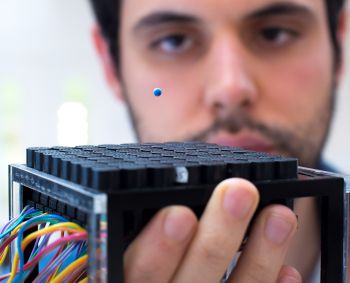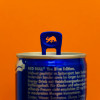'Star Trek' sonic tractor beam invented
Interview with
If you don't know what a tractor beam is, then you possibly didn't watch enough  Star Trek! But - for the uninitiated - this is a way of manipulating objects at a distance, and Bristol University's Bruce Drinkwater has managed to do it using patterns of sound waves, which he fashions into a sonic "cage" in the air that can trap things. And if you move the sonic cage, whatever's inside moves with it. The discovery could make a big difference to the way we practise medicine, as Chris Smith found out...
Star Trek! But - for the uninitiated - this is a way of manipulating objects at a distance, and Bristol University's Bruce Drinkwater has managed to do it using patterns of sound waves, which he fashions into a sonic "cage" in the air that can trap things. And if you move the sonic cage, whatever's inside moves with it. The discovery could make a big difference to the way we practise medicine, as Chris Smith found out...
Bruce - We've made the world's first fully functional tractor beam. For it to be a tractor beam, it's got to be able to grab an objects from one side, so that means there's got to be a source of the energy - in our case, sound waves - it's got to travel out, it's got to grab the object, and we've got to be able to pull that object back towards the source.
Chris - Talk us through the experimental approach then. What do you do and how does it work?
Bruce - So, imagine in front of you an array of lots of little loud speakers. The array is about the size of a dinner plate basically and each of the loud speakers is about a size of your thumbnail. They're all outputting sound waves. The key for us is to carefully control the way in which those individual outputs from all those different loud speakers interfere.
So, we're creating an interference pattern. We refer to that as an acoustic hologram because it's three dimensional, though you can't see any of it, there's a three dimensional sound field there. If you could go in there and listen to it, the sound would vary in three dimensions. And so, we've carefully tuned the output of those loud speakers to create these very special conditions that produce ultimately, tractor beam effects of levitation, rotation, movement.
Chris - What frequencies in other words, what's the pitch of the sound that's coming out? Would I be able to hear it?
Bruce - No. You wouldn't be able to hear it. So, our current system is operating at 40 Kilohertz. So, your ears can hear somewhere between 15 and 20 Kilohertz depending on your age. So, we're well above that. We're in the range that bats and dogs and cats could hear. So they probably wouldn't like our experiment. But the good thing about that frequency range is it means we can use really loud sounds and yet, we still can't hear them.
Chris - The sound comes out of this ray of speakers and the different waves are interacting with each other in a way that you're carefully controlling. When they do that and they create this three dimensional holographic sound effect, this soundscape, what effect does that have then on things that are within the area of influence of that sound?
Bruce - The best way of describing this tractor beam and these trapping points is, the objects that we're levitating and trapping are at a quiet location. So, the sound level is very low and they're surrounded by a cage of high intensity sound. So if they try to move, they're pushed back by this high intensity sound.
Chris - What sorts of objects can this influence?
Bruce - Their full range isn't yet known. We've worked on a scale of millimetres. So at 40 kilohertz, the wavelength of sound in air is about a centimetre. So, we can only levitate objects that are small and about half of that. So we're up to about five millimetres so the size of a small pea.
You could scale this in either direction. You could go to both smaller scale or larger scale, which might be of more interest to sci-fi fans. Unfortunately, if you get to a larger scale then that means lower frequency which eventually means you'll be able to hear it.
Chris - What's the range? Presumably, the sound is spreading out away from the loud speaker ray and therefore, becoming weaker with distance. So, there must be a point at which it won't work anymore.
Bruce - Yeah, you're quite right. You have to achieve certain levels of sound intensity in the vicinity of the object that you're levitating. You need something like 140 and 150, perhaps higher, decibels in that locality and so yeah, as the sound propagates, so it decays.
Our system can levitate things up to about 30 centimetres away from it. If we had more powerful transducers, we could extend that. I could imagine it wouldn't be too difficult to extend it to half a metre, possibly metre.
Chris - Now, this is working in air and it relies on the fact that you're putting energy from your speakers into the air and making the air molecules vibrate which creates these areas where you've got a calm spot where the object wants to sit. If you used a different medium, for instance, if you put this into a cylinder of a very dense gas or a very light gas, would it behave differently?
Bruce - One of the nice things about acoustics is that everything scales with the wavelength. So, as long as these waves exist, these phenomenon that we're talking about exists. So, if you go to a different medium, the wavelength will change for a given frequency, but the physics doesn't actually change. So yeah, it's applicable to any medium. I'm really interested in water-like medium and in particular, tissue because I'm interested in taking this technology to manipulate objects within the human body.
Chris - You could for instance operate on someone by manipulating an object inside their body by sending these sound waves in to create guide and signals for that object from outside.
Bruce - Yeah, I think so. I think the one to go for first is targeted drug delivery. So, there's currently quite a lot of bit of work and interest in this whole area, but the idea would be, you'd encapsulate drugs in little capsules - very, very small so it could be injected - and then you could move them to the desired location with this tractor beam technology and then blast them open with a pulse of ultrasound. So, you could deliver the drugs precisely to the location within the body you wanted to.
- Previous Mel Greaves - Evolving cancer
- Next Changes in DNA are NOT random










Comments
Add a comment